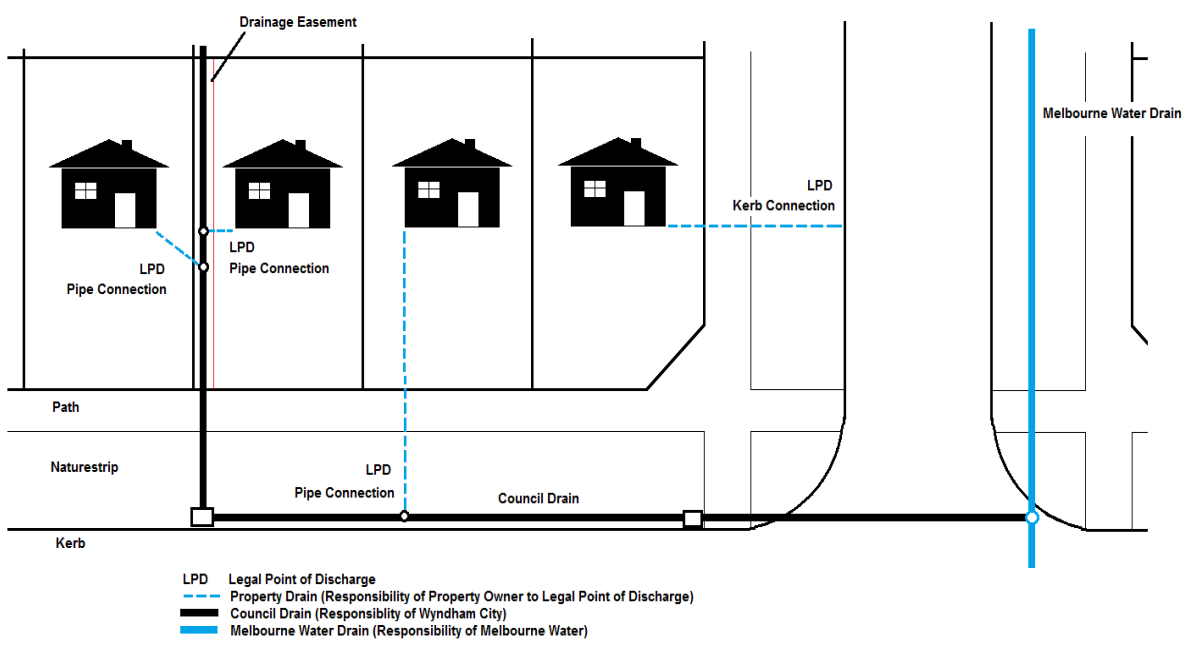What is an Easement?
An easement is a section of land registered on a Land Title, that gives someone the right to use that section for a specific purpose; even though they are not the property owner. Easements will usually contain pipelines for the disposal of stormwater and sewerage. These pipelines and associated inspection pits (infrastructure) are owned and maintained by the relevant service authority.
To determine whether your property has an easement, you must obtain a copy of your Plan of Subdivision from the Land Titles Office.
If Council is noted as a beneficiary to the easement, that means that Council has rights to utilise the easement and may already have storm water infrastructure contained within it.
If another service authority is noted as a beneficiary to the easement, you must contact that authority directly for further information.
Submission of a Before You Dig Australia query via www.byda.com.au will confirm whether the easement contains any service authority infrastructure.
If the easement contains a Council storm water pipeline, and you would like to obtain pipeline data (eg. diameter, offset, depth), you must submit a Legal Point of Discharge application.
Planting over an Easement
Approval is not required from Council to plant over an easement. Items such as grass and shrubs can be freely planted. However, trees are restricted to a species that will only have a shallow root system when mature and will not cause detriment to any Council storm water infrastructure contained within the easement.
Building over an Easement
Regulation 130(1) of the Building Regulations 2018 requires the Report and Consent of a service authority to build in, under or over an easement that is vested in favour of that service authority. Examples of common service authorities are, Council (storm water) and Greater Western Water (sewerage).
Council will not consider build over easement approval for any of the following proposals where the easement contains Council storm water infrastructure:
- Habitable structures.
- Structures that share the same roofline with a dwelling.
- Service connection and utility infrastructure.
- Private services such as hot water systems and meters.
- Swimming pools and spas (above or below ground).
- Water tanks.
Footings near or within an Easement
Any proposed footings within the vicinity of an easement must be designed to maintain a minimum clearance of 600mm from Council’s storm water infrastructure. In circumstances where there is a Council storm water inspection pit located within an easement, footings must maintain a 1.0m clearance from the edge of the pit.
It is the responsibility of the private structural engineer to ensure that any proposed footing within the vicinity of an easement has been designed to maintain angle of repose from Council’s stormwater pipeline, or inspection pit, in addition to maintaining the relevant clearances.
Apply to Build over an Easement under Regulation 130(1)
To apply for build over easement approval, you must submit a Build Over Easement application form and provide all the necessary documentation for assessment.
Download Consent to Site a Structure Over Easement Form
What is a Legal Point of Discharge?
The Legal Point of Discharge refers to the location where storm water exits a property and is authorised to discharge into Council’s drainage infrastructure, or another storm water capture provision.
The Legal Point of Discharge does not refer to a physical pipeline. It refers to a location only. The pipeline that connects a property to Council’s infrastructure is called a house drain or a property drain.
Apply for a Legal Point of Discharge certificate under Regulation 133(2)
To apply for a legal point of discharge certificate, you must submit a Legal Point of Discharge and Council Easement information application form.
Download Legal Point of Discharge application form
Storm Water Responsibilities
Council is a designated drainage authority along with Melbourne Water and has responsibilities conferred upon it by State legislation. The responsibilities of Council and property owners in relation to storm water drainage and access can be viewed by downloading the Storm Water Pipes & Easements (Responsibilities & Access) fact sheet.
Responsibilities Diagram
Private Storm Water
Council does not hold information relating to the private storm water pipelines around the perimeter of dwellings/buildings. Property owners requiring the alignment of private pipelines on their property must engage a plumber to conduct a site analysis or CCTV investigation.
Related documents
- Roads and Maintenance - Stormwater Legal Point of Discharge Form (PDF, 176.79 KB)
- Roads and Maintenance - Build Over Easement Application Form (word) (DOC, 685.39 KB)
